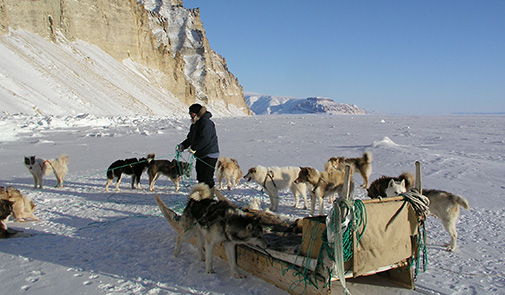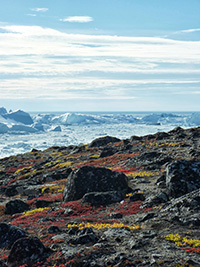Human genes adapted to life in the Arctic
Danish researchers, in collaboration with researchers in the United States and Britain, have studied the DNA of Greenlanders whose Inuit forefathers have been living in the Arctic for tens of thousands of years. The Arctic is an extreme environment, characterised by a cold climate and sparse vegetation, an environment that has forced the Inuit to adapt. Their success at doing so is reflected in their genetic material.
The study has just been published in the renown journal, Science, and tells us much about the fantastic ability humans have to adapt to diverse environments. The traditional diet of Greenlanders primarily consists of protein and fat from fish and marine mammals, while – due to a lack of vegetables – carbohydrate consumption is minimal. The new study reveals how the Inuit have adapted to these living conditions.
By using genetic information from 4500 Greenlanders, researchers investigated which genes have changed the most over the roughly 20,000 years since the Greenlanders’ most ancient ancestors separated from their nearest East Asian relatives, the Han Chinese.
“By comparing the DNA of Greenlanders with DNA from the Chinese Han population, we quickly discovered that a few genes have changed so much that the changes cannot have happened simply by chance. Instead, the changes must be the result of genetic adaptation via natural selection,” explains Assistant Professor Ida Moltke of the Section for Computational and RNA Biology at the University of Copenhagen’s Department of Biology. Moltke is one of the Science article’s two lead authors.
The researchers have also discovered that all the identified genes are in some way related to fat, e.g. involved in synthesis of fatty acids.
“By studying the concentration of fatty acids in the cell membranes of Greenlanders, we found out that the genetic changes allows the Greenlandic Inuit to compensate for their traditionally high intake of certain omega-3 and omega-6 fatty acids from fish, among other things,” explains Associate Professor Anders Albrechtsen of the Section for Computational and RNA Biology at the University of Copenhagen’s Department of Biology. Albrechtsen is one of the study’s principal investigators.
Adaptations affect height as well
The composition of fatty acids is not the only trait affected by the genetic changes. The research also showed that one of the genetic changes, a specific mutation, has had a large effect on height as well.
“The effect of this mutation on height is a very interesting observation. We were able to see that the mutation has a significant effect on the height of Greenlanders. While previous studies on the height of Europeans have been conducted, the effect of this particular mutation has never been discovered before. This is because the mutation is much less common among Europeans, and therefore 50 times as many European individuals would be required to reveal the effect of the mutation. This clearly shows the advantage of studying small and historically isolated populations,” says Professor Torben Hansen of the Novo Nordisk Foundation Center for Basic Metabolic Research at the University of Copenhagen. Hansen is one of the study’s other principal investigators. The researchers are keen on continuing their work with Greenlanders. “In their DNA the Greenlanders carry a vast amount of important information about both diseases and the history of human evolution, which makes the Greenlanders a truly valuable source of new knowledge,” concludes Professor Hansen.
Collaboration
The research study is the result of collaboration between research groups from the Department of Biology at the University of Copenhagen, the Novo Nordisk Foundation Center for Basic Metabolic Research at the University of Copenhagen, the University of California, Berkeley, University College London, the Steno Diabetes Center and the University of Southern Denmark.
Thanks to
First and foremost, thanks to all of the Greenlanders who took part in this study. And to Professor Peter Bjerregaard and Professor Marit Eika Jørgensen, who collected the large amount of data.
The project is funded by the Novo Nordisk Foundation Center for Basic Metabolic Research, Section of Metabolic Genetics, Faculty of Health and Medical Sciences at the University of Copenhagen (www.metabol.ku.dk), as well as by a project grant and YDUN grant from the Danish Council for Independent Research.
Science article: https://www.sciencemag.org/content/349/6254/1343
Contact
Assistant professor Ida Moltke
Department of Biology
University of Copenhagen
Phone:+45 2970 0849
Email: ida@bio.ku.dk
Associate professor Anders Albrechtsen
Department of Biology
University of Copenhagen
Phone: +45 35 33 02 46
Email: aalbrechtsen@bio.ku.dk
Topics
Fact box
The study shows the genetic evolution of Greenlanders over the past 20,000 years. This process of genetic adaptation probably began around 19,000 years ago, when the Greenlanders’ ancestors inhabited in the Arctic and thus long before they settled in Greenland about 1000 years ago. Therefore, not only the Greenlandic Inuit carry the mutation; all Inuit populations and Native Americans, carry it as well.
Contacts
Population Genetics
Ida Moltke
Assistant professor
Department of Biology
University of Copenhagen
+45 2970 0849
Anders Albrechtsen
Associate professor
Department of Biology
University of Copenhagen
+45 2197 4249
Rasmus Nielsen
Professor
Department of Integrative Biology
University of California Berkeley
+15 10 20 65 715
Matteo Fumagalli
Research associate
Department of Genetics, Evolution,
and Environment
University College London
Metabolic Genetics
Torben Hansen
Dr. MD / professor
The Novo Nordisk Foundation Center
for Basic Metabolic Research
Faculty of Health and Medical Sciences
University of Copenhagen
+45 2056 5301
Niels Grarup
Dr. MD / assistant professor
The Novo Nordisk Foundation Center
for Basic Metabolic Research
Faculty of Health and Medical Sciences
University of Copenhagen
+45 2448 2914
Epidemiology (Greenland)
Marit Jørgensen
Dr. MD / professor
National Institute of Public Health
University of Southern Denmark
and Steno Diabetes Center
+45 6550 7777
Peter Bjerregaard
Professor
National Institute of Public Health
University of Southern Denmark
and Greenland Center for Health Research
University of Greenland
Fact box
Our current understanding of how humans adapt to various environments around the world is incredibly limited. Nevertheless, adaptation has been critical for the ability of humans to populate the greater part of this planet. Humans are able to live in a tremendously wide variety of environments, from the ice cold Artic, to areas with large malaria risks, as well as the extreme altitude of Tibet and the Himalayas.
There are only a few examples of adaption, besides the one described in the new study of the Greenlandic Inuit, for which the genetic background is known. One of them is a study of Tibetans conducted by Professor Rasmus Nielsen of the University of California, Berkeley. Nielsen is also one of the principal investigators of the new study on Greenlanders. In the study of Tibetans he showed that Tibetans have adapted to the lower levels of oxygen in mountainous Tibet, through a mutation of a single gene that affects haemoglobin levels of its carriers (Yi et al 2010).


